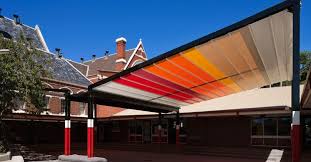Exploring Trends in Shade Sail Technology
Title: Sailing into the Future: Exploring Trends in Shade Sail Technology
Introduction:
Shade sails have become an integral part of outdoor spaces, offering protection from the sun's harsh rays while adding aesthetic appeal to various environments. As technology continues to advance, the world of shade sails is undergoing significant transformations. From innovative materials to smart design solutions, the future of shade sail technology promises increased durability, efficiency, and functionality. In this article, we will delve into the emerging trends shaping the landscape of shade sail technology.
- Advanced Materials:
Traditional shade sails are typically made from materials like polyester or high-density polyethylene (HDPE). However, advancements in material science are paving the way for the development of more durable and weather-resistant fabrics. For instance, researchers are exploring the use of nanoparticle coatings to enhance the UV protection and waterproof properties of shade sail materials. These coatings can prolong the lifespan of the sails and improve their performance in challenging weather conditions.
Additionally, there is growing interest in sustainable materials for shade sails. Manufacturers are experimenting with eco-friendly fabrics derived from recycled materials or renewable sources such as bamboo and hemp. These sustainable alternatives not only reduce the environmental impact but also offer comparable durability and UV protection.
- Smart Design Solutions:
The integration of technology into shade sail design is another notable trend. Smart sensors and actuators can be embedded within the sails to enhance functionality and user experience. For example, automated retractable shade sails can adjust their position based on environmental factors such as sunlight intensity and wind speed. This ensures optimal shading throughout the day while minimizing the risk of damage during adverse weather conditions.
Furthermore, advancements in 3D modeling and simulation software are enabling designers to create highly customized shade sail configurations. By simulating various design options virtually, designers can optimize the shape, size, and orientation of the sails to maximize shading efficiency and aesthetic appeal.
- Modular and Versatile Systems:
Modularity is becoming increasingly important in Domestic shade sails technology, allowing for greater flexibility and adaptability in installation. Modular systems consist of interconnected sail panels that can be combined and rearranged to fit different spaces and configurations. This versatility makes modular shade sail systems ideal for both temporary and permanent installations, such as outdoor events, residential patios, and commercial spaces.
Moreover, modular systems enable easy maintenance and repair. Instead of replacing an entire sail in case of damage, individual panels can be swapped out, reducing downtime and cost.
- Integration with Renewable Energy:
As sustainability becomes a key focus across industries, there is growing interest in integrating shade sails with renewable energy technologies. Solar photovoltaic (PV) panels can be incorporated into the fabric of shade sails, allowing them to generate clean electricity while providing shade. This dual functionality makes shade sails a viable option for eco-conscious consumers and businesses looking to reduce their carbon footprint.
Furthermore, shade sails can be combined with rainwater harvesting systems to collect and store water for irrigation or other purposes. By capturing rainwater runoff, shade sails contribute to water conservation efforts while enhancing the sustainability of outdoor spaces.
Conclusion:
The future of shade sail technology is bright, with innovations poised to revolutionize the way we think about outdoor shading solutions. Advanced materials, smart design solutions, modular systems, and integration with renewable energy are driving the evolution of shade sails, making them more durable, efficient, and sustainable than ever before. As these trends continue to unfold, we can expect shade sails to play an increasingly important role in creating comfortable and environmentally friendly outdoor environments.


No comments yet